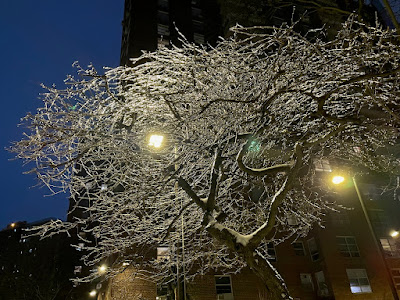 The ceiling of a central gallery in the Natural History Museum in London has since 2009 offered visitors "TREE," a work by Tania Kovats commissioned for Charles Darwin's 200th and the Origin of Species 150th birthdays. This is a "wafer-thin" slice of an actual tree - a two hundred year old oak - inspired by the famous drawing in Darwin's notebooks of 1837 which seems to capture the moment
The ceiling of a central gallery in the Natural History Museum in London has since 2009 offered visitors "TREE," a work by Tania Kovats commissioned for Charles Darwin's 200th and the Origin of Species 150th birthdays. This is a "wafer-thin" slice of an actual tree - a two hundred year old oak - inspired by the famous drawing in Darwin's notebooks of 1837 which seems to capture the moment he discovered the theory of evolution. The museum's video about the making of "TREE" ends with the superposition of Kovacs' work, the source tree while still standing, and Darwin's sketch. I can't find images of what it looks like from right underneath it but the one below at least offers a tree's eye view. It must be most impressive and a little sinister, the museum's largest botanical specimen!
Kovats' work is simply called "TREE" but, despite her requests, is described by visitors and ultimately the museum too the way Darwin's doodle is, as a "tree of life." And yet it's not even clear that Darwin's drawing represented a tree. One scholar has argued that Darwin's model was coral. It seems more likely that the image of a tree of life was a preexisting one which Darwin made use of, as is suggested by the way he uses the image in Origin of Species 22 years later.
The affinities of all the beings of the same class have sometimes been represented by a great tree. I believe this simile largely speaks the truth. . . . As buds give rise by growth to fresh buds, and these, if vigorous, branch out and overtop on all sides many a feebler branch, so by generation I believe it has been with the great Tree of Life, which fills with its dead and broken branches the crust of the earth, and covers the surface with its ever branching and beautiful ramifications.
The twiggy drawing wasn't in fact the first in that notebook in which Darwin was feeling his way toward the theory of evolution. Two others appear a few pages before, each of the three corresponding to a central element of the emerging theory. Adaptation, gaps in the fossil record, and - for this third one - extinctions. When more than just the evocative "I think" is included in your image, we see ongoing thought.
The original image seems designed to make sense of the "immense gap of relation" between A (bottom right) and B (top), relative to the smaller but also different gaps between B and C, and between B and D. Beside the image come two later thought bubbles which lead to the epiphany that the process described "requires extinction." (text) Maybe he made the later connection between his theory and representations of species affinities as a tree with the inescapability of extinctions in mind - a way to recognize kinship with the defunct.There have been many problems identified in thinking of all of life as a tree, not least because of the implications of lateral gene transfer. But I'm intrigued that part of the value Darwin saw in the tree simile was the fact that trees lose branches: "the great Tree of Life ... fills with its dead and broken branches the crust of the earth, and covers the surface with its ever branching and beautiful ramifications." As a botanist Darwin appreciated that trees grow through loss.
My main inspiration in these reflections is an article I stumbled on by Nils Petter Hellström, “The tree as evolutionary icon: TREE in the Natural History Museum, London,” Archives of natural history 38.1 (2011): 1–17, and rabbit holes it led me to.














.jpeg)
















